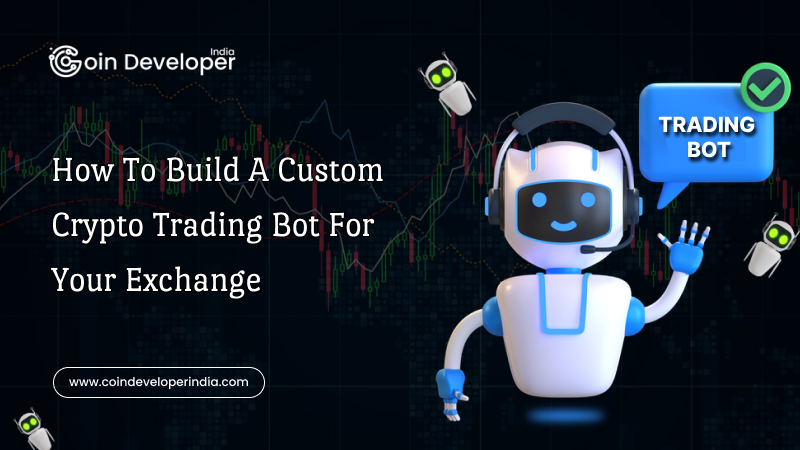Are you looking to build a custom crypto trading bot for your exchange? If yes, you have come to the right place.
In 2024, the crypto trading bot market was valued at around USD 41.61 billion and is projected to grow significantly, reaching approximately USD 154 billion by 2033. This growth reflects a compound annual growth rate (CAGR) of roughly 14% between 2025 and 2033.
In today’s world of cryptocurrency trading, automation is becoming a game-changer. With markets open 24/7 and volatility creating countless opportunities and risks, having a crypto trading bot powered by an advanced trading system is like hiring a tireless digital trader who never sleeps, panics, and always executes on time.
For exchanges, offering or integrating a custom trading bot adds value, improves liquidity, and enhances user engagement.
This guide explains how to build a tailored crypto trading bot that fits seamlessly into your trading platform, covering everything from strategy selection to deployment, technology choices, and the benefits of keeping development in-house.
Why Custom Trading Bots Are Crucial for Exchanges?
While many traders use off-the-shelf bots, a custom-built solution designed specifically for your exchange offers unmatched advantages. It provides complete control over features, performance, and security, making it an asset rather than a dependency.
For instance, custom bots can be fine-tuned to handle your platform’s latency, integrate proprietary APIs, and align with your liquidity pools. Beyond just technical performance, they become a tool for user acquisition and retention, especially when marketed as premium offerings for power traders or institutional clients.
Additionally, having your bot avoids the risks associated with third-party solutions, which might be buggy, outdated, or vulnerable to exploits. When built in-house or with a trusted development partner, your bot becomes a long-term strategic asset.
How Crypto Trading Bots Operate?
A crypto trading bot is essentially a program that interacts with an exchange’s API to collect data, generate signals, and execute trades. It works through an organized set of modules that ensure automation is not only possible but also efficient and safe.
The bot begins by accessing live market feeds like price charts, order books, and historical data. This data is analyzed using a set of trading strategies, ranging from simple moving averages to AI-powered prediction models. Based on this analysis, the bot generates a buy or sell signal.
Before executing the trade, risk controls are applied to ensure capital protection through stop-losses, position sizing, and portfolio balancing.
The final step involves placing the order directly through your exchange’s trading engine, monitoring its status, and adapting dynamically if the market moves rapidly.
Steps to Develop a Custom Crypto Trading Bot
Step 1: Planning and Strategy: The Foundation of a Good Bot
Before jumping into Custom Crypto Trading Bot development, it’s vital to clarify what kind of trading bot you’re building and who it serves. Bots can vary significantly, from simple market-making scripts to advanced bots capable of high-frequency trading (HFT).
If you’re targeting retail users, simplicity and user-friendliness are key. For institutional clients, performance and customizability will take priority. Bots designed for spot trading are fundamentally different from those handling perpetual futures or margin trades. Clearly defining these parameters ensures the right architectural and strategic choices are made from the beginning.
The strategy you implement, such as arbitrage, mean reversion, or trend following, will influence everything from your data requirements to how often the bot places trades.
Step 2: Architecture and Development Flow
Building a robust trading bot requires a well-planned architecture that supports modularity, low latency, and high availability. At its core, the system typically includes five main components: data ingestion, signal generation, risk management, trade execution, and user interaction.
The data ingestion module continuously gathers live data from your exchange’s APIs. The signal generation engine then processes this data to identify potential trades based on the selected strategies. Risk management modules ensure trades are executed with predefined limits. The execution engine then interfaces with your exchange’s order book to place, cancel, or modify trades.
For added flexibility, a web-based dashboard or admin panel allows your users or internal analysts to track performance, switch strategies, and configure risk settings in real-time.
Step 3: Choosing the Right Technology Stack
The technology stack you choose directly impacts the performance, scalability, and maintainability of your trading bot. For backend development, Python is a popular choice due to its vast ecosystem of trading libraries and ease of writing algorithmic logic. However, for low-latency needs, languages like Go or C++ may be more suitable.
On the frontend, a framework like React or Vue.js can help you build clean, responsive dashboards. Databases such as PostgreSQL or MongoDB are useful for storing trade logs and user settings. For AI-enabled bots, frameworks like TensorFlow or PyTorch allow the integration of predictive modelling.
Choosing a cloud provider like AWS or Azure ensures scalability and high availability, especially during peak trading times. For communication between services, technologies like WebSockets and Kafka are essential for real-time performance.
Step 4: Integrating AI and Machine Learning
Advanced trading bots can go a step further by integrating AI/ML to identify complex market patterns. These bots can learn from historical data to make more informed decisions, optimize trade entry and exit points, and even self-adapt based on performance feedback.
Machine learning models can help detect trends earlier or flag anomalies that traditional technical analysis may miss. That said, deploying AI bots also requires backtesting against diverse market conditions, robust validation processes, and fail-safes to prevent erratic decisions.
This layer of intelligence is optional but can be a strong competitive differentiator, especially for bots used by professional traders.
Step 5: Security Is Non-Negotiable
Given that your bot will be handling real trades and user funds, security must be a top priority. Implementing multi-factor authentication (MFA), encrypted data storage, and secure API key handling is essential.
Make sure the bot has strict rate-limiting controls and access management policies. It should never store private keys or sensitive credentials in plaintext. Role-based permissions and audit logs add another layer of accountability.
If the bot is made available to your customers, regular security audits and code reviews are a must. A single breach can lead to huge financial and reputational damage, so build with a security-first mindset from day one.
Step 6: Testing and Backtesting
No trading bot should go live without extensive testing. Start with unit testing for individual modules, then proceed to integration testing where the full system works together in a sandbox environment.
Backtesting is crucial—run your bot using historical data across different periods to see how it would have performed. This helps refine your strategy, avoid overfitting, and understand the bot’s behaviour in different market conditions like bull runs, crashes, or flat trends.
Additionally, perform paper trading on live markets with fake funds to observe real-time performance without financial risk. Only after these steps should you consider full deployment.
Step 7: Deployment and Maintenance
Once the bot passes all tests, it’s ready for deployment. Set up real-time monitoring tools to track performance, resource usage, and system uptime. You’ll also want to implement alert systems for anomalies or errors, such as trades not executing or server downtimes.
Ongoing maintenance includes regular software updates, strategy tweaks based on market changes, and user feedback implementation. For public bots offered to users, provide support, documentation, and update logs to build trust and credibility.
It’s also important to monitor regulatory changes in your target regions to ensure compliance, especially if your bot is actively trading on behalf of others.
How Much Does it Cost to Develop a Crypto Trading Bot?
The cost of developing a crypto trading bot in 2025 typically ranges from $5,000 to $50,000, depending on complexity, exchange integrations, supported strategies, and real-time analytics. Basic bots with standard trading algorithms cost less, while advanced AI-powered bots with custom strategy development, security layers, and cloud deployment increase expenses.
Additional costs may include API access fees, ongoing maintenance, and third-party tool integration. Hiring an experienced crypto trading bot development company ensures optimized performance, scalability, and compliance with regulatory standards.
For startups and traders, investing in a reliable bot can enhance trading efficiency, reduce risks, and maximize profitability across volatile crypto markets.
Final Thoughts
Building a custom crypto trading bot for your exchange is a high-value investment that pays off through improved trading volume, better liquidity, and an enhanced user experience. It allows you to differentiate your platform, attract high-volume traders, and even introduce new monetization models through premium bot access.
With the right planning, technology, and ongoing support, your custom trading bot can become one of the core pillars of your crypto ecosystem.
Coin Developer India is your trusted partner for building secure, high-performance crypto trading bots tailored to your exchange platform!






